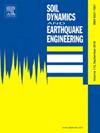Study on the spatial effects of seismic motion on ultra-long integrated transportation hubs
IF 4.2
2区 工程技术
Q1 ENGINEERING, GEOLOGICAL
引用次数: 0
Abstract
The seismic responses of large-space, long-span, and ultra-long structures exhibit significant differences based on their spatial effects; therefore, it is necessary to conduct an analysis of the seismic responses of various specific structures. To synthesize artificial three-dimensional (3-D) seismic waves based on the 3-D coherence function matrix and traditional trigonometric series method, lower-upper decomposition was used to achieve 3-D coherence matrix decomposition, and the Fourier amplitude spectra method was used to adjust the acceleration time-history. Moreover, the acceleration initialization method and trend elimination using least squares were used to achieve baseline correction. Based on the unidirectional, bidirectional, and triaxial consistent and inconsistent excitation modes, four natural waves and two artificial waves were used for the aseismic calculations of an actual ultra-long structure. The results showed that the excitation dimension had little impact on the inter-story drift ratios, and the traveling-wave effect did not have a serious negative impact on the rotation-displacement ratios. However, the cases of short-side and low-apparent-wave-velocity excitations were unfavorable for the control of story drift and shear force, and the coherent effect significantly increased the peak internal force of the components. There was a greater effect under short-side excitation and a high apparent wave velocity, whereas at a low apparent wave velocity, the traveling-wave effect was strengthened, and component internal forces exhibited polarization. The combined traveling-wave and coherent effects were unfavorable for structural safety. The excitation dimension had little impact on peak internal force and the number of overloaded components under incoherent excitation but a significant impact under coherent excitation, especially triaxial coherent excitation.
地震运动对超长综合交通枢纽的空间效应研究
基于空间效应,大空间、大跨度和超长结构的地震反应表现出显著差异;因此,有必要对各种特定结构的地震反应进行分析。基于三维相干函数矩阵和传统三角级数法合成人工三维地震波,采用上下分解实现三维相干矩阵分解,采用傅立叶振幅谱法调整加速度时程。采用加速度初始化法和最小二乘趋势消除法实现基线校正。基于单向、双向、三轴一致和不一致激励模式,采用4种自然波和2种人工波对某实际超长结构进行了抗震计算。结果表明:激励尺寸对层间位移比的影响较小,行波效应对层间位移比的影响不大;然而,短边和低表观波速激励情况不利于层间漂移和剪切力的控制,相干效应显著提高了构件的峰值内力。在短边激励和高视波速下,行波效应增强,分量内力呈现极化现象。行波和相干效应的联合作用不利于结构的安全。在非相干激励下,激励尺寸对峰值内力和过载构件数的影响较小,但在相干激励下,尤其是三轴相干激励下,影响较大。
本文章由计算机程序翻译,如有差异,请以英文原文为准。
求助全文
约1分钟内获得全文
求助全文
来源期刊

Soil Dynamics and Earthquake Engineering
工程技术-地球科学综合
CiteScore
7.50
自引率
15.00%
发文量
446
审稿时长
8 months
期刊介绍:
The journal aims to encourage and enhance the role of mechanics and other disciplines as they relate to earthquake engineering by providing opportunities for the publication of the work of applied mathematicians, engineers and other applied scientists involved in solving problems closely related to the field of earthquake engineering and geotechnical earthquake engineering.
Emphasis is placed on new concepts and techniques, but case histories will also be published if they enhance the presentation and understanding of new technical concepts.
 求助内容:
求助内容: 应助结果提醒方式:
应助结果提醒方式:


